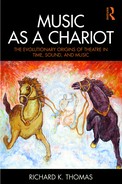Contents
Introduction: An Ear-Opening Experience
When Sound Gets Divorced from Music
Introduction: If a Tree Falls in the Universe …
The Evolution of Hearing and Seeing
The Evolution of the Brain Leads to the Ability to Express Emotions
Introduction: Babbling in Babelsberg
We Are Such Stuff as Dreams Are Made Of …
Part II
Music = Time Manipulated
Introduction: What’s in a Name?
Narrowing Our Definition of Music
Music Is Visual as Well as Audible
Complex Elements that Combine Energy in Time and Space
The Importance of These Elements of Music
A Proposed Definition of Music
Music, Language and Theatre: The Really Early Years
6 Campfire Songs: Rhythm and Entrainment
Running, Tempo, Pulse, Tactus and Entrainment
Tempo, Pacing, Tactus, Entrainment and Theatre Composition
Introduction: “All Theatre Starts with a Script”
Conclusion: Song = Music + Idea
8 Consonance and Dissonance: The Evolution of Line
Introduction: The Roots of Who We Become
What Is Consonance and Dissonance?
Subcortical Consonance and Dissonance Perception
Cortical Consonance and Dissonance Perception
Consonance and Dissonance in Theatre
Conclusion: Consonance and Dissonance and Time
Part IV
Theatre = Song + Mimesis
9 Ritual, Arousal, Reward, Ecstasy
Introduction: From High Mass to Ecstasy
The Development of Ritual, Shamanism, and Altered States of Consciousness
Introduction: Dreams, Altered States of Consciousness and Theatre
The Basic Neuroscience of Arousal
The Effect of Music on Physiological Systems
The Effect of Music on Psychological Systems
Cognitive Models for Music in Theatre
Robert Thayer’s Model of Psychological Moods
Berlyne’s Theory of Arousal in Aesthetics and Psychobiology
Conclusion: Experiments in Ecstasy
Introduction: Traveling Backward in Time
Long Auditory Store/Short Term Memory/Working Memory
Creating and Retrieving Long-Term Memories
Involuntary Explicit Episodic Memory
Conclusion: The Origins of Theatre and the Problems of the Oral Tradition
11 The Bronze Age and the Invention of Writing
Introduction: Theatre Becomes Drama
The Emergence of Written Language
The Transition from Oral Tradition to Recorded History
Conclusion: Lost in Translation?
12 Conclusion: Evolution and Greek Theatre
The Origins of Greek Music: Music = Time Manipulated
The Development of Greek Song: Song = Music + Idea
Music as Math Made Audible: The Greeks Revisit Consonance and Dissonance
